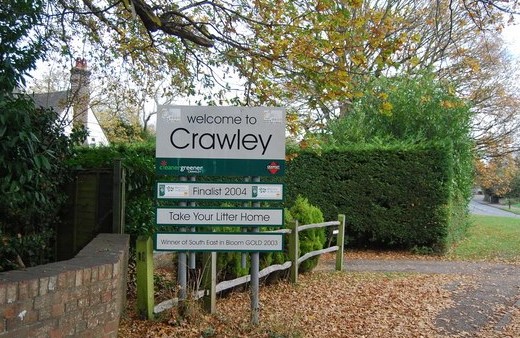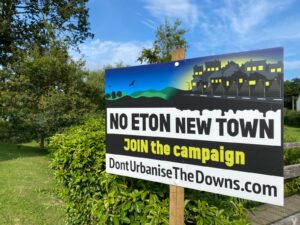Today I’m going to write about an ethical thought experiment called “the trolley problem”, why Greta Thunberg seemingly doesn’t like windfarms and the imaginary island of Utopia, created in the mind of Thomas More in 1515. And if none of that is of interest, then you definitely don’t live in Plumpton.
Let’s start with “the trolley problem”. Trolley is not just what Dominic Cummings calls Boris Johnson (because he just smashes into things apparently) but also the American word for tram.
The ethical dilemma presented by the problem is that there is an out-of-control trolley/tram running down a track, heading towards some points – controlled by a lever you hold.
If you don’t pull the lever, then the five people standing on the line will be crushed and die. If you do pull the lever then the tram will change course and it will run over a single person on that line, killing them instead.
In most studies of this problem, roughly 90 per cent of people pick the option of pulling the lever and killing one instead of five. Which makes sense.
What’s interesting is that if that one random person becomes someone you know and love, it can be half that, dependent on things like age – and who knows if you really did have the lever in your hand, what you’d do in that split second.
What we’re learning here is that most people, looking at things without bias, want to choose the greater good. But, quite naturally, when their self-interests and the interests of those they love are on the line, the picture becomes a lot murkier.
Then we have the windfarms. Last month Greta Thunberg, essentially the face of environmentalism, was arrested for the second time protesting about a Norwegian onshore windfarm.
She, and other protesters, want the 151 turbines removed because they apparently upset the animals of the indigenous people that live in that area.
You would think that she would be in favour of renewable energy and, in essence, she is. We can possibly draw many conclusions from this, but the one I would draw is that if you can’t place wind turbines in a virtually unoccupied part of the Arctic Circle because it upsets animals, then it’s hard to see where you can place them.
Lastly, we have Thomas More and his vision of the perfect community. His Utopian vision, which included new ideas such as free healthcare for all, was one of the influences behind the idea of new towns.
The first were created in this country with the New Towns Act 1946 and those towns – including Welwyn Garden City and Crawley and, later, Milton Keynes – have on the whole become phenomenally successful.
They recognised the “vital need to house the population in places that secured the population’s happiness and wellbeing” – as described in “New Towns, the Rise, Fall and Rebirth” by Katy Lock and Hugh Ellis.
And they did this by tackling every part of the built environment to better people’s lives – by creating cycle lanes, tree-lined avenues and sustainable homes for all, along with a myriad of other benefits not possible by simply adapting our existing cities.

And that brings us to the people of Plumpton, and others, and where is best to place new housing. You see, wherever you place housing there must be compromise – it’s always going to upset somebody.
In the United States, there are proposals such as the incredible new city of Telosa, miles from anyone else. But our country is too small to build a city of five million people on land not really being used for anything.
Ninety per cent plus of the UK is not built on but each unoccupied parcel is visible from the many settlements around.
Our choices then, on where to build, essentially fall into three categories. Extending most small settlements, gradually, bit by bit, perhaps at the expense of their charm and way of life along with environmental and infrastructure problems is the first.
The changes in planning policy as part of the upcoming Levelling Up Bill are really shutting the door on that. For better or worse, the occupants of rural villages have had enough.
The second is the regeneration of our cities and increasing their housing density. As an urban developer, this is what we do. And I believe firmly in making the best of what we have as opposed to just leaving rundown areas to rot – not to mention creating new exciting buildings and employing new technology.
But as much as I love Brighton and Hove, you can see in everything from the poor excuse we have for cycle lanes to the rubbish floating around our pavements and to the potholes in the narrow roads we’ve dug up a dozen times that the basic infrastructure of towns laid out 150 years ago or more can only be stretched so far.
And the cost of the land and building here rarely allows us to pay for the affordable housing we so badly need, even in the most expensive of areas.

The third option then is (small) new towns such as that proposed on land outside Plumpton at North Barnes Farm.
Building this way can give us large amounts of affordable housing, the latest technology, truly sustainable houses and flats, new purpose-built schools and medical facilities, green spaces and everything within walking distance.
Segregated cycle lanes, high-speed internet and inclusive community thinking from the off. This is only, truly possible by starting from new on a large scale.
As a developer, I’m not involved in the Plumpton project nor, given the size of the schemes we’re talking about is it ever likely I would be building a new town. But the benefits are quite clear.
Are there concerns? Of course. From the environmental impact to the issues of infrastructure and to the effect of the views from the South Downs National Park among others.
It would be churlish to say you can’t make an omelette without breaking a few eggs – but these are deep-rooted concerns and fears held by those most directly affected and, once built, there is no going back. I realise that. I do.
There will be many things to overcome, not least the environmental concerns, and plenty of people will never accept this kind of development.
But if we consider it truly without bias as we do in “the trolley problem” and accept that if we can never find a perfect answer that upsets nothing and no one (unlike Greta), you can see the huge benefits in this sort of project that is best for the country and the next generation of those living here.
We need to accept compromises in our society to move forward, forward to the closest to Utopia we can find.
Ed Deedman is a director of Cayuga Homes.









If Mr Deedman’s idea of utopian towns is Crawley I fear of the people of Plumpton.
Morning Richard. I wouldn’t want to disparage Crawley, but yes, I think things have moved on a bit since then.
Phenomenally successful and Crawley in the same breath? Sure this is a joke article.
Nope – by most metrics new towns have been incredibly successful. The fact that Crawley continues to grow tells you they must have done something right, although, as in my answer above, that doesn’t mean it can’t be improved this time around.
Blah blah blah blah…..
Big words